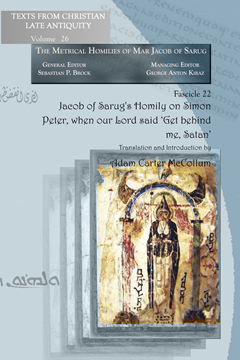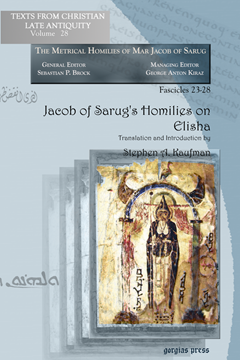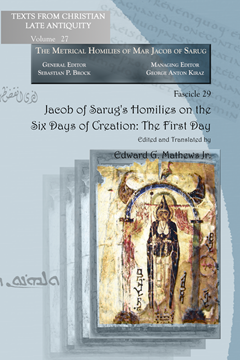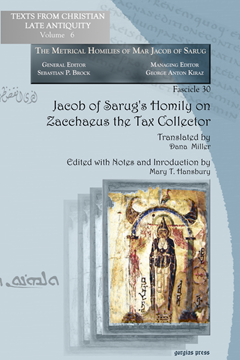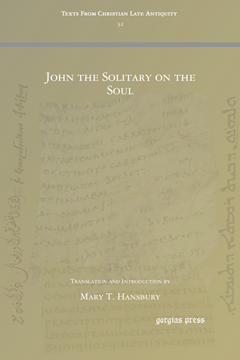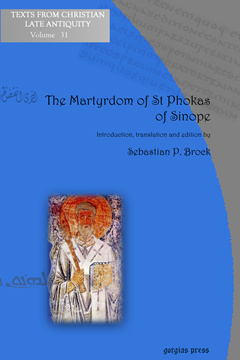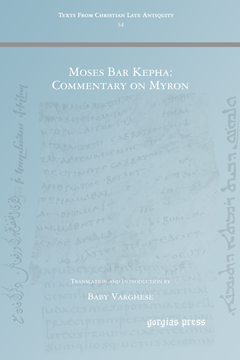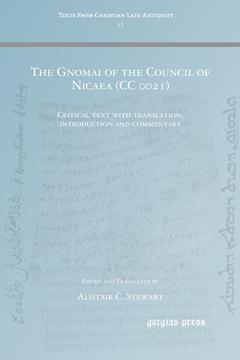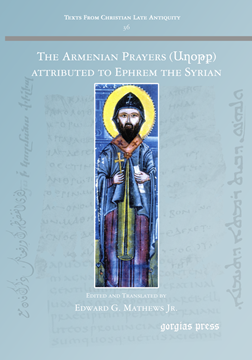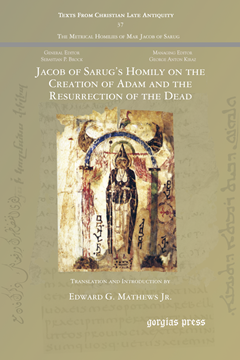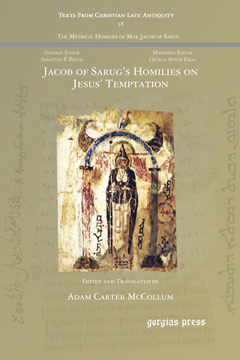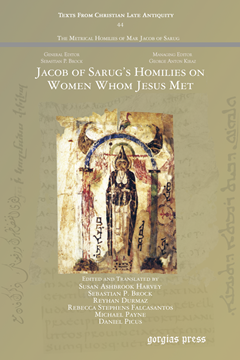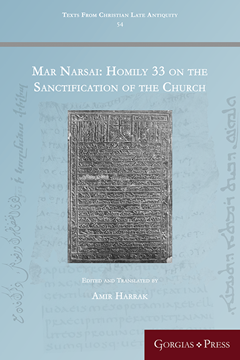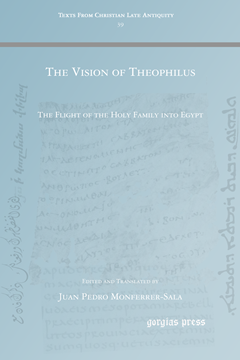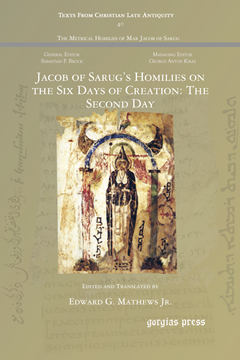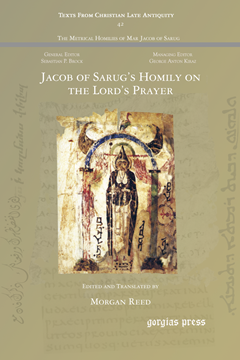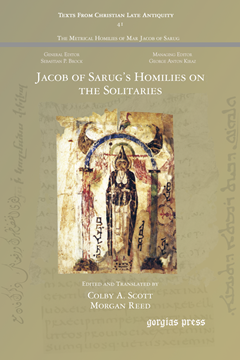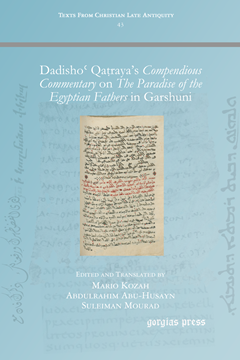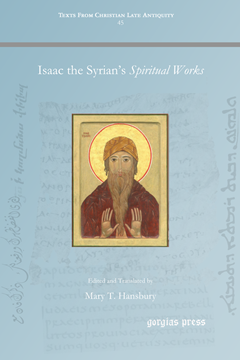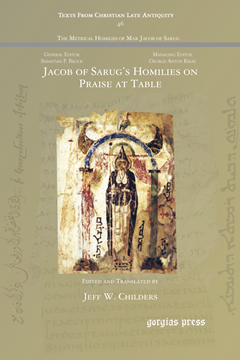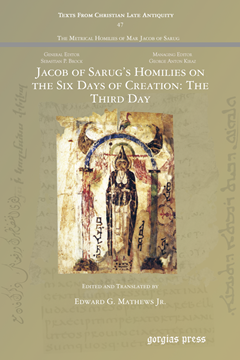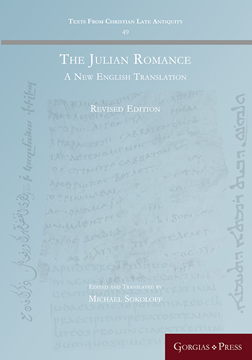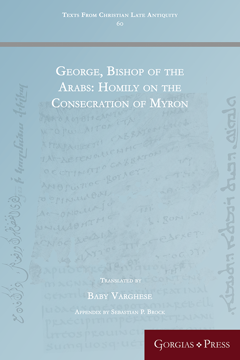Texts from Christian Late Antiquity
TeCLA (Texts from Christian Late Antiquity) is a series presenting ancient Christian texts both in their original languages and with accompanying contemporary English translations.
Jacob of Sarug’s Homily on Simon Peter, when our Lord said ‘Get behind me, Satan’
Translation and Introduction by Adam Carter McCollum
Series: Texts from Christian Late Antiquity 26
ISBN: 978-1-60724-214-7
Jacob of Sarug's (d. 521) homily on Simon Peter, when our Lord said, “Get behind me Satan!” (Matt 16:23) touches the themes of Jesus’ divinity and death, warfare with Satan, the harrowing of hell, and his relationship with Peter. Peter’s rebuke of Jesus’ willingness to die gives Jesus (through Jacob) the occasion to explain what his death will accomplish. The volume constitutes a fascicle of The Metrical Homilies of Mar Jacob of Sarug, which, when complete, will contain the original Syriac text of Jacob's surviving sermons, fully vocalized, alongside an annotated English translation.
$33.00 (USD)
Jacob of Sarug’s Homilies on Elisha
Metrical Homilies of Mar Jacob of Sarug
Translation and Introduction by Stephen A. Kaufman
Series: Texts from Christian Late Antiquity 28
ISBN: 978-1-60724-302-1
This edition of Mar Jacob of Sarug's (d. 521) homilies on the prophet Elisha deals with some of the more difficult stories in the Old Testament, how to understand the story of the bears who ravage the children who made fun of the prophet and why the sacrifice by the King of Moab of his son to his pagan god was seemingly successful. The volume constitutes a fascicle of The Metrical Homilies of Mar Jacob of Sarug, which, when complete, will contain the original Syriac text of Jacob's surviving sermons, fully vocalized, alongside an annotated English translation.
$83.00 (USD)
Jacob of Sarug’s Homilies on the Six Days of Creation (The First Day)
The First Day
Edited and Translated by Edward G Mathews Jr
Series: Texts from Christian Late Antiquity 27
ISBN: 978-1-60724-323-6
Jacob of Sarug's (d. 521) homily constitutes the first example of a Hexameron, or Commentary on the Six Days of Creation, in Syriac literature. This edition presents Jacob’s comments on the first day, Gen. 1:1-5. The volume constitutes a fascicle of The Metrical Homilies of Mar Jacob of Sarug, which, when complete, will contain the original Syriac text of Jacob's surviving sermons, fully vocalized, alongside an annotated English translation.
$34.00 (USD)
Jacob of Sarug’s Homily on Zacchaeus the Tax Collector
Metrical Homilies of Mar Jacob of Sarug
Translated by Dana Miller; Edited with Notes and Introduction by Mary T. Hansbury
Series: Texts from Christian Late Antiquity 6
ISBN: 978-1-61719-660-7
This edition of Mar Jacob of Sarug's (d. 521) homily on Zacchaeus the tax-collector makes the point that Christ’s path goes by those most in need of repentance. Zacchaeus recognizes his shortcomings and is healed by Christ, who then makes Zacchaeus a mirror or sign for all humanity to see. The volume constitutes a fascicle of The Metrical Homilies of Mar Jacob of Sarug, which, when complete, will contain the original Syriac text of Jacob's surviving sermons, fully vocalized, alongside an annotated English translation.
$33.00 (USD)
Ephrem the Syrian's Hymns on the Unleavened Bread
Translation and Introduction by J. Edward Walters
Series: Texts from Christian Late Antiquity 30
ISBN: 978-1-4632-0159-3
In this set of homilies Ephrem (306-373) invites the reader into a world of symbolic interpretation filled with imagination brimming beneath the surface of word-plays, alliteration, and typological comparisons. These hymns thrust the reader into the middle of a context in which Christians and Jews maintain competing practices of a Passover service to the extent that Ephrem feels the need to distinguish between the symbol and the reality. These homilies are presented in their Syriac original alongside an annotated English translation.
$41.00 (USD)
John the Solitary on the Soul
Translation and Introduction by Mary T. Hansbury
Series: Texts from Christian Late Antiquity 32
ISBN: 978-1-60724-044-0
In this treatise, John the Solitary (ca. 390) enters into a dialogue with two disciples who have come past the beginning stage of the spiritual life and have brought him their struggle against the passions in the life of the inner person (barnâšâ gawwâyâ). John’s description of the life of the soul is outlined here in a framework of the stages of the spiritual life. Included is his analysis of the passions, showing very little if any Evagrian influence. The Dialogue on the Soul is a difficult text. It is hoped that this Syriac-English presentation will enable others to take the discussion forward. John’s genial thought merits this.
$61.00 (USD)
The Martyrdom of St Phokas of Sinope
The Syriac Version
Introduction, translation and edition by Sebastian P. Brock
Series: Texts from Christian Late Antiquity 31
ISBN: 978-1-4632-0189-0
The fame of the martyr St. Phokas, first bishop of Sinope (on the Black Sea) and patron of seafarers, had spread to many parts of the Christian world by the fifth and sixth centuries. Although the Acts of his martyrdom under Trajan were composed in Greek, the earliest witness to them is the Syriac translation which is edited and translated here from two early manuscripts.
$34.00 (USD)
Commentary on Myron
Translation and Introduction by Fr. Baby Varghese
Series: Texts from Christian Late Antiquity 34
ISBN: 978-1-4632-0214-9
Moses bar Kepha: Commentary on Myron is an important witness to the history of the West Syriac Liturgy. Fr. Baby Varghese has translated the Syriac text into English for the first time.
$37.00 (USD)
The Gnomai of the Council of Nicaea (CC 0021)
Critical text with translation, introduction and commentary
Edited and Translated by Alistair C. Stewart
Series: Texts from Christian Late Antiquity 35
ISBN: 978-1-4632-0260-6
The first English translation and first complete critical text of a neglected moral treatise from fourth-century Egypt, throwing fresh light on the social history of Egyptian Christianity and on the growth of the church-order tradition.
$43.00 (USD)
The Armenian Prayers attributed to Ephrem the Syrian
Edited and Translated by Edward G Mathews Jr
Series: Texts from Christian Late Antiquity 36
ISBN: 978-1-4632-0262-0
Armenian text of the Prayers attributed to Ephrem the Syrian, with the first-ever translation into a western language. Utilizing a highly developed poetic rhythm, the author manifests a profound spirituality laying his own emptiness before the inexhaustible Mercy of God.
$53.00 (USD)
Jacob of Sarug's Homily on the Creation of Adam and the Resurrection of the Dead
Translation and Introduction by Edward G Mathews Jr
Series: Texts from Christian Late Antiquity 37
ISBN: 978-1-4632-0264-4
Mêmrâ 72 is a meditation on the fall of Adam and its consequences, subjecting all creation to corruption. God’s mercy, however, will restore everything to a spiritual, incorruptible state that will exist eternally in the unending light of Christ.
$34.00 (USD)
Jacob of Sarug’s Homilies on Jesus' Temptation
Edited and Translated by Adam Carter McCollum
Series: Texts from Christian Late Antiquity 38
ISBN: 978-1-4632-0285-9
This volume presents, with introduction and annotations, two metrical homilies (Bedjan nos. 82, 126) of Jacob of Sarug in which he reflects on the Temptation of Jesus as combat between Satan and Jesus, the latter emerging as the humble victor.
$47.00 (USD)
Jacob of Sarug's Homilies on Women Whom Jesus Met
Edited and Translated by Susan Ashbrook Harvey, Sebastian P. Brock, Professor Reyhan Durmaz, Rebecca Stephens Falcasantos, Michael L. Payne & Prof. Daniel Picus
Series: Texts from Christian Late Antiquity 44
ISBN: 978-1-4632-0580-5
Five homilies by Jacob of Sarug on women whom Jesus met: the Canaanite Woman, the Samaritan Woman, the Hemorrhaging Woman, the Woman Bent Double, and Jairus' Daughter.
$37.00 (USD)
Homily 33 on the Sanctification of the Church
Edited and Translated by Amir Harrak
Series: Texts from Christian Late Antiquity 54
ISBN: 978-1-4632-0552-2
Narsai’s memra 33 is made of 12 by 12 syllables, and its title “On the Sanctification of the Church” suggests that it was written for the feast of the Dedication of the Church celebrated by the Church of the East to this day on the first of November. The memra names the Church of the Nations the Bride of the Bridegroom Christ. The Church had a pagan origin but Christ chose her to become his bride. He thus saved her through his suffering, cleansed her with baptism, prepared the bridal feast for her through the Eucharist, and crowned her victory over all the nations.
$53.00 (USD)
The Vision of Theophilus
The Flight of the Holy Family into Egypt
Edited and Translated by Juan Pedro Monferrer-Sala
Series: Texts from Christian Late Antiquity 39
ISBN: 978-1-4632-0550-8
A critical edition of a fragmentary Arabic manuscript (Mingana Chr. Arab. 18), together with a study which suggests that the three Arabic versions do not represent three different texts, but rather three versions all drawing on the same original text.
$43.00 (USD)
Jacob of Sarug’s Homilies on the Six Days of Creation (The Second Day)
The Second Day
Edited and Translated by Edward G Mathews Jr
Series: Texts from Christian Late Antiquity 40
ISBN: 978-1-4632-0553-9
In this second part of Homily 71, On the Fashioning of Creation, Jacob treats the making of the firmament: what it was, where it was, what – as far as can be determined – was placed above it and what below it, its purpose and utility for humanity, and the importance of its place in the Genesis account of the six day progression of creation.
$30.00 (USD)
Jacob of Sarug's Homily on the Lord's Prayer
Edited and Translated by Morgan Reed
Series: Texts from Christian Late Antiquity 42
ISBN: 978-1-4632-0561-4
Jacob of Sarug's pastoral concern and rhetorical acumen have earned him the title “the lyre of the Holy Spirit”. This volume presents both a text and translation of Jacob’s exposition of a passage central to Christian liturgy and piety.
$39.00 (USD)
Jacob of Sarug's Homilies on the Solitaries
Edited and Translated by Colby A. Scott & Morgan Reed
Series: Texts from Christian Late Antiquity 41
ISBN: 978-1-4632-0562-1
Jacob of Sarug's pastoral concern and rhetorical acumen have appropriately earned him the title “the lyre of the Holy Spirit”. This volume presents Jacob's admonitions to those living a life of consecrated singleness to God.
$44.00 (USD)
Dadishoʿ Qaṭraya’s Compendious Commentary on The Paradise of the Egyptian Fathers
in Garshuni
Series: Texts from Christian Late Antiquity 43
ISBN: 978-1-4632-0566-9
The Compendious Commentary by the Church of the East monk Dadishoʿ Qaṭraya (7th cent.) was originally written in Syriac but was eventually translated into Garshuni or Syro-Arabic. It is a work aimed at immersing the novice monk in the spiritual lore of the monastic vocation, and saturating his mind and spirit with advice and warnings about the pitfalls of aiming to be perfect while remaining nevertheless an imperfect human being. This is a critical edition and translation of the Compendious Commentary in Garshuni that uses all available manuscripts.
$85.00 (USD)
Isaac the Syrian's Spiritual Works
Edited and Translated by Mary T. Hansbury
Series: Texts from Christian Late Antiquity 45
ISBN: 978-1-4632-0593-5
Isaac the Syrian lived the solitary life in the 7th century. He was born in Qatar and subsequently lived in present day Iraq and Iran. After life as a monk, then briefly as a bishop, he withdrew to live the solitary life. These discourses are primarily for solitaries to consolidate them in the love and mercy of God. In this volume, the text of Isaac V has also been included because of the light which it sheds on Apocatastasis, of increasing interest in academic and ecclesial circles.
$90.00 (USD)
Jacob of Sarug's Homilies on Praise at Table
Edited and Translated by Jeff W. Childers
Series: Texts from Christian Late Antiquity 46
ISBN: 978-1-4632-0605-5
Part of a series of fascicles containing the bilingual Syriac-English editions of Saint Jacob of Sarug’s homilies, this volume contains his homilies on Praise at Table. These homilies offer a glimpse into the efforts of one late antique author to construct distinctly Christian meaning from the experience of communal meal-sharing. The Syriac text is fully vocalized, and the translation is annotated with a commentary and biblical references. The volume is one of the fascicles of Gorgias Press’s The Metrical Homilies of Mar Jacob of Sarug, which, when complete, will contain all of Jacob’s surviving sermons. Recognized as a saint by both Chalcedonian and non-Chalcedonian Christians alike, Jacob of Sarug (d. 521) produced many narrative poems that have rarely been translated into English. Of his reported 760 metrical homilies, only about half survive.
$47.00 (USD)
The Works of Cyrillona
Edited and Translated by Carl Griffin
Series: Texts from Christian Late Antiquity 48
ISBN: 978-1-4632-0606-2
Cyrillona (fl. 396) has been ranked among the foremost early Syriac poets since his work was rediscovered by scholars in the mid-19th century. His Holy Week discourses on the Last Supper, the Washing of the Feet, and the Institution of the Eucharist have become particularly well-known to western readers through quotations by such diverse authors as Hugo Rahner and Photina Rech. This volume presents the first modern critical edition of Cyrillona’s Syriac works together with the first complete English translation.
$60.00 (USD)
Jacob of Sarug’s Homilies on the Six Days of Creation (The Third Day)
The Third Day
Edited and Translated by Edward G Mathews Jr
Series: Texts from Christian Late Antiquity 47
ISBN: 978-1-4632-0615-4
In this third part of Homily 71, On the Fashioning of Creation, Jacob treats the God's separation of the waters from the earth, and the bringing forth of vegetation on the newly-revealed dry land.
$32.00 (USD)
The Julian Romance (revised)
A New English Translation
Edited and Translated by Michael Sokoloff
Series: Texts from Christian Late Antiquity 49
ISBN: 978-1-4632-0708-3
The so-called "Julian Romance" was discovered among the Nitrian manuscripts in the 1830s. This revised edition, with facing Syriac text and English translation, provides a new, more accurate translation of this important Syriac text.
$107.00 (USD)
George, Bishop of the Arabs
Homily on the Consecration of Myron
Translated by Fr. Baby Varghese
Series: Texts from Christian Late Antiquity 60
ISBN: 978-1-4632-0731-1
George was one of the last scholarly Syrian Orthodox bishops to live in the early Islamic period. His metrical homily, probably composed to be sung during the consecration of the Myron, is presented here with the vocalised Syriac text and English translation on facing pages.
$35.00 (USD) $28.00 (USD)

